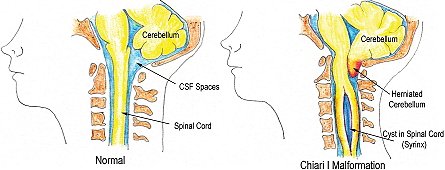Chiari Malformation Causes, Symptoms, Diagnosis and Treatment

What Is Chiari Malformation?
Chiari malformations is a term which refers to structural defects in cerebellum, a part of the brain which is responsible for balance and movement.
It causes the cerebellar tonsils to be displaced downwards through the foramen magnum (the opening at the base of the skull), which in turn may cause non-communicating hydrocephalus, as a result of obstruction of cerebrospinal fluid (CSF) outflow.
It is generally categorized into three types, depending on the anatomy of the displaced brain tissue. The most common chiari malformations are Type I and Type II.
Chiari malformations in turn can lead to development of serious conditions. Such conditions include:
- Spina bifida
- Syringomyelia, in which a cavity or cyst (syrinx) forms within the spinal column.
- Tethered cord syndrome, leading toserious nerve and muscle damage in the lower body.
Causes Of Chiari Malformations:
Chiari malformations occur due to structural defects in the brain. These defects may be caused by:
- Defect during fetal development
- Genetic mutations
- Maternal diet, which may have lacked in some necessary nutrients
- Injury
- Infection
- Exposure to toxic substances
Symptoms Of Chiari Malformation:
Symptoms of chiari malformation includes:
- Headaches intensified by Valsalva maneuvers, such as:
Yawning
Laughing
Crying
Coughing
sneezing or straining
bending over
getting up suddenly - Tinnitus
- Lhermitte’s sign (electrical sensation that runs down the back and into the limbs)
- Vertigo
- Nausea
- Nystagmus (irregular eye movements; typically)
- Facial pain
- Muscle weakness
- Impaired gag reflex
- Dysphagia (difficulty swallowing)
- Restless leg syndrome
- Sleep apnea
- Sleep disorders
- Impaired coordination
- bulbar palsy
- Paralysis
- Papilledema on fundoscopic exam due to Increased intracranial pressure
- Pupillary dilation
- Dysautonomia: tachycardia (rapid heart), syncope (fainting), polydipsia (extreme thirst), chronic fatigue
Diagnosis Of Chiari Malformation:
Chiari malformation can be diagnosed via:
- A medical history
- Physical examination
- Imaging tests
MRI, to monitor the progression of the disorder
CT scan, to detect other complications resulted by chiari malformations
Treatment Of Chiari Malformation:
Chiari malformation can be treated via:
- Medications
Pain killers, to relieve headaches and neck pain - Decompression surgery, to reduce pressure at the base of the brain
- Endoscopic third ventriculostomy (ETV), where a small hole is made in the wall of one of the cavities of the brain, releasing the trapped fluid.
- Ventriculoperitoneal shunting, which involves drilling a small hole into the skull and passing a thin tube called a catheter into the brain cavity to drain the trapped fluid and relieve the pressure.
- Untethering, which involves separating the spinal cord and releasing tension in the spine
By : Natural Health News




